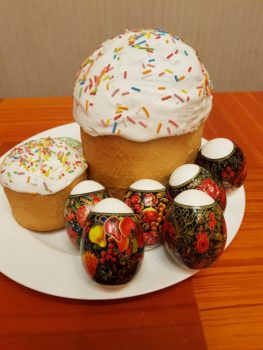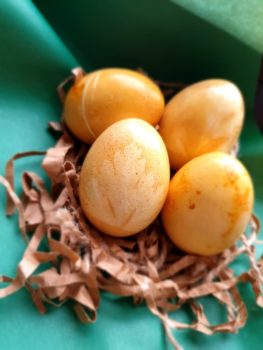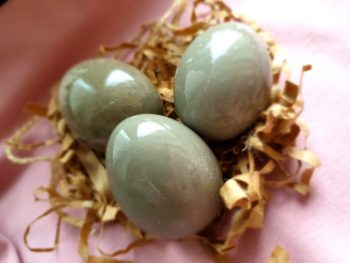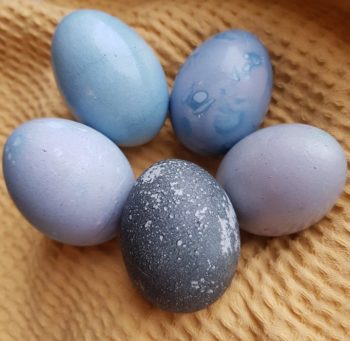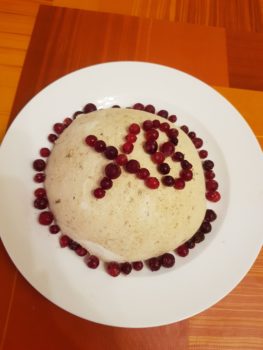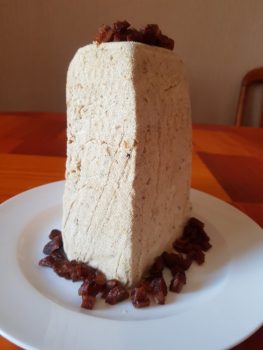DIY ideas for Paskha Posted by bota on May 4, 2021 in Culture, Food, Holidays, Russian life, Traditions, when in Russia
Правосла́вная Па́сха вы́пала на второе ма́я в э́том го́ду. (Orthodox Easter fell on May 2nd this year) and I wanted to share как мы с брати́шкой и сестрёнкой первый раз кра́сили яйца (how I and my siblings dyed eggs for the first time) и как мы пригото́вили па́сху (and how we made a paskha). My family doesn’t celebrate Orthodox Easter but we cherish the traditions around it. And every year since first grade my best friend’s grandma would give me куличи и пасха́льные яйца на па́сху (kulich and Easter eggs for Paskha.) I’m happy to report this year her baked treats were more delicious than ever (see the photo).
*All photos taken and used with permission from author (Akbota Yergaliyeva)
*Grammar notes: there isn’t a direct equivalent of the word ‘sibling’ in Russian, that’s why I wrote ‘my siblings and I’ like this: “мы с брати́шкой и сестрёнкой”. Also, it’s common to use ‘мы с тобой’ to mean ‘you and I’ in Russian even though ‘мы’ means ‘we’.
Как мы кра́сили пасха́льные яйца с натура́льными краси́телями (How we dyed Easter eggs with natural dyes)
There are so many замеча́тельных (wonderful) and креати́вных (creative) tutorials on how to make your Easter eggs very festive для пасха́льного стола́ (for the Easter table). I’ve referenced tutorials in Russian here so that you can practice your listening skills but there are plenty in English too.
Turmeric
My siblings and I were inspired by this wonderful tutorial but didn’t follow it too closely mostly because we were having fun with the process. Our first attempt at dying eggs was with turmeric (куркума́) and the result was this beautiful warm golden color.
We did make отва́р из куркумы (turmeric mixture) and посоли́ли его (put salt in it) to prevent the eggs from cracking, but we didn’t boil the eggs separately and just cooked them in the turmeric water for 10 min. To make the ‘leaf’ and ‘stripes’ designs we did things from a different tutorial. On the picture above you can see the imprint of листо́чек петру́шки (a parsley leaf) and the far-left egg was boiled with рези́нка для де́нег (a rubber band for money) around it.
Hibiscus Tea
Our second batch was made the following morning and was rather unplanned. We saw some leftover каркаде́ (hibiscus tea) in the teapot and used that mixture to dye a few more eggs. But, unlike the recipe, we only had about 20-30 grams of tea, so our mixture wasn’t as concentrated as the original recipe (80 grams). However, after being boiled for 10 minutes, the eggs turned this subtle grey color. Кста́ти (by the way), we polished both batches with some vegetable oil to add a nice shine for the photos.
Red Cabbage
We had the most fun dying eggs with red cabbage (краснокоча́нная капу́ста) since each eggs turned out differently even though the original отва́р (the cabbage and water mixture) looked very purple (фиоле́товый). So, depending on the amount of wine vinegar we added to each jar, the eggs turned from a lovely soft blue color (голубо́го цве́та) to a mate lilac-grey (ма́товый лилово-се́рый). The darkest grey one was from another leftover hibiscus tea but this time with added wine vinegar.
There is one popular method we haven’t tried yet and that’s dying Easter eggs with луковой шелухой (onion peels). It gives the eggs a very pleasant deep reddish-brown hue, but the caveat is the amount of onion peels (dry outer layer) that has to be saved in advance. Most recipes recommend red and yellow peels from 10-15 large onions and some even suggest to start saving them from Ма́сленица (Maslenitsa). I will have to post about dying eggs with onion peels на сле́дующую па́сху (for next Easter) since we didn’t have that many onions to spare.
Lastly, we also made вку́сную творо́жную па́сху (a delicious ‘cottage-cheese’ paskha) following this recipe. We didn’t have a special paskha-mold to give the dessert the shape of a truncated pyramid that’s said to be a symbol of the Tomb of Christ. Luckily, many Russians have shared their creative ideas on the internet for how to use household items as baking molds and a good-old cheese grater and a metal strainer worked for us.
Do you celebrate Па́сха (Paskha) and what are some of your favorite recipes, DIY projects, and traditions? I would love to hear about your experience in the comments.

Build vocabulary, practice pronunciation, and more with Transparent Language Online. Available anytime, anywhere, on any device.



